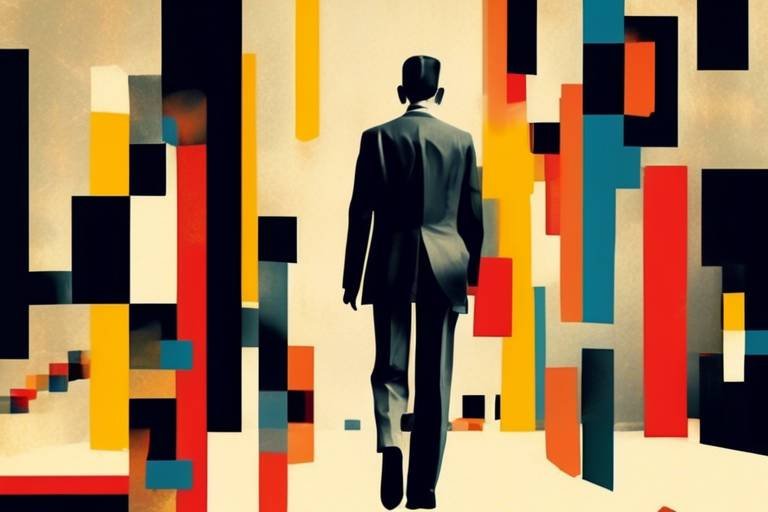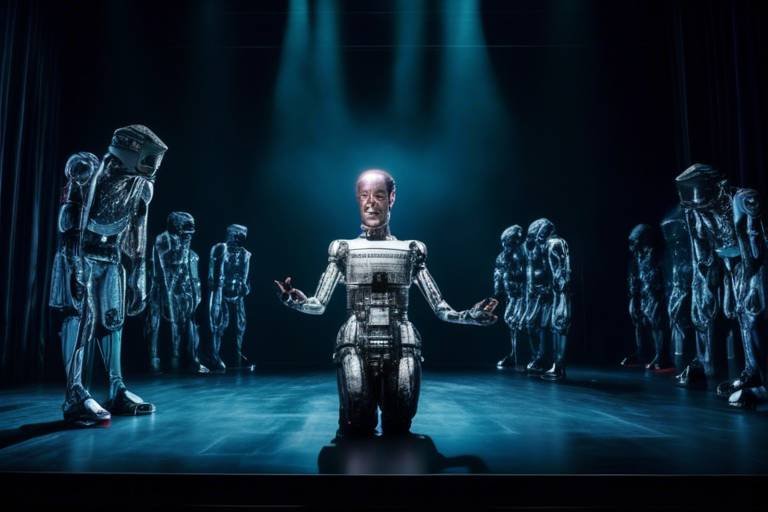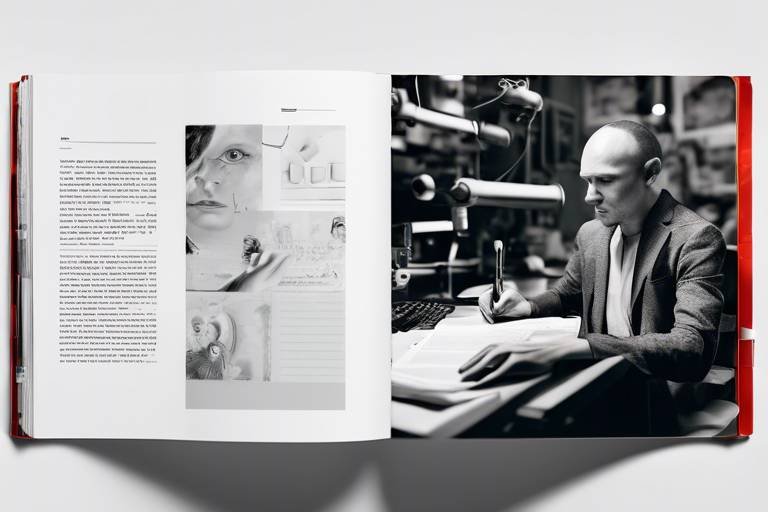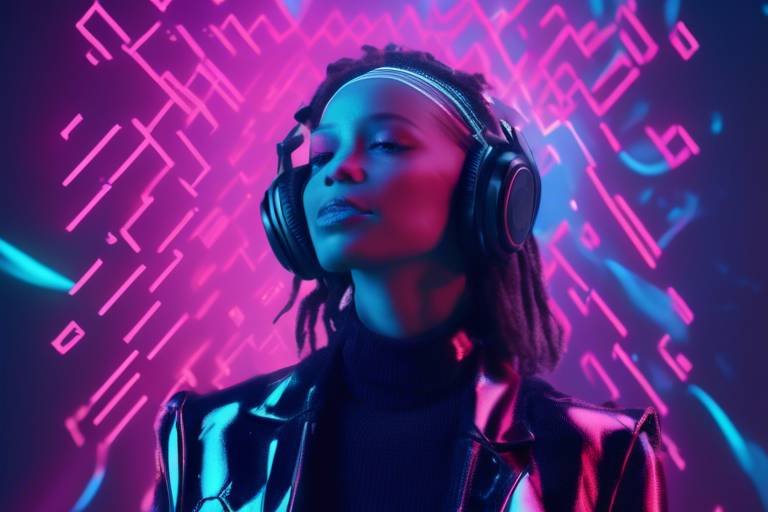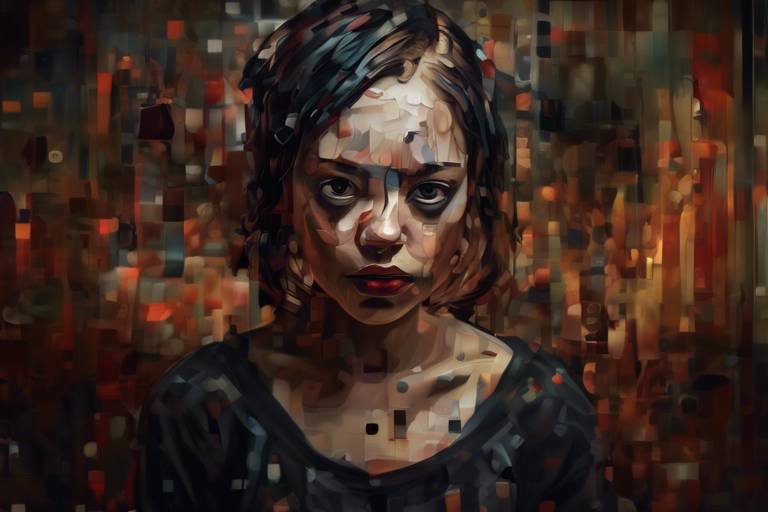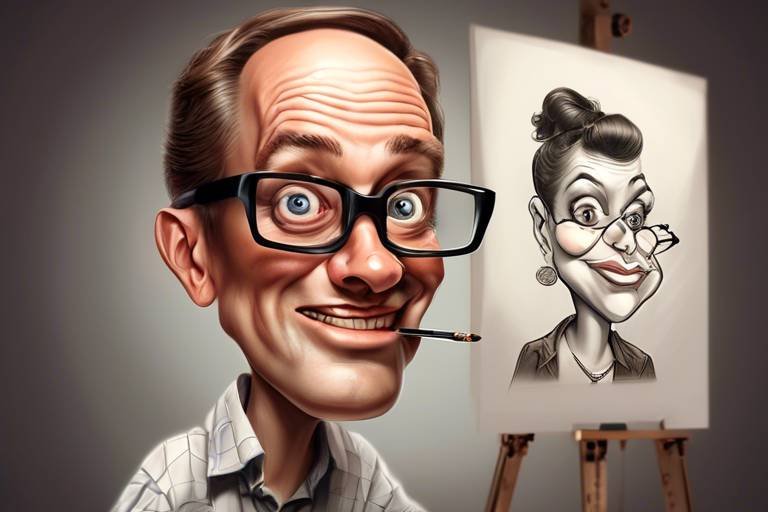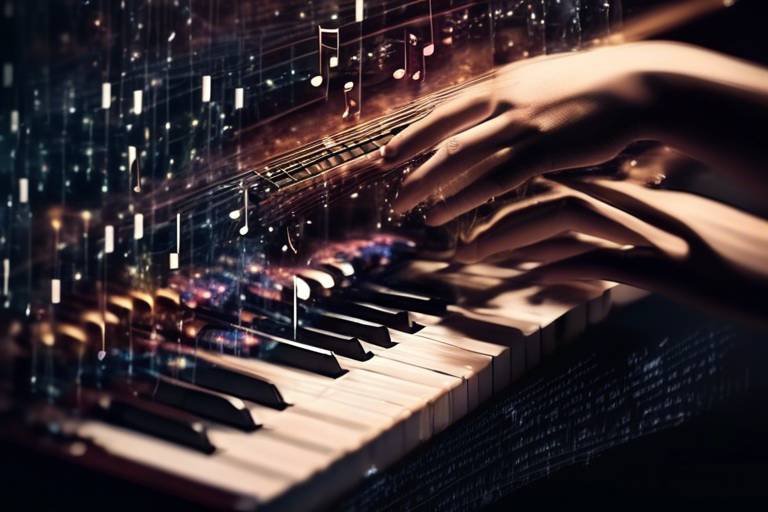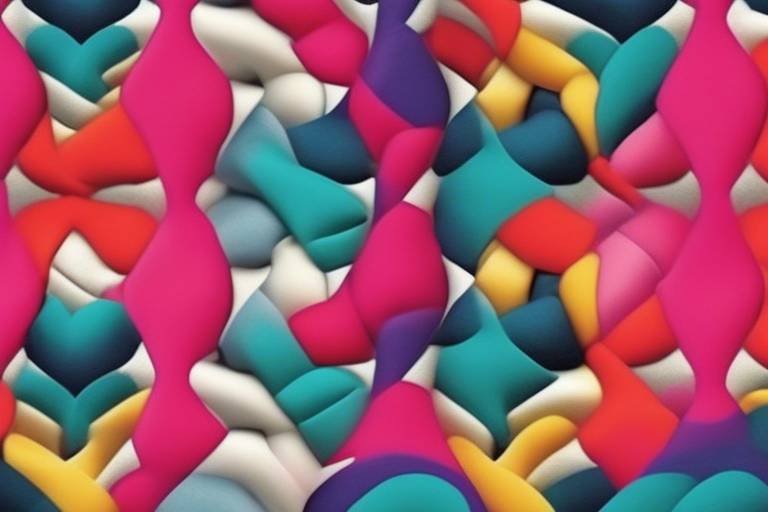Revolutionizing Art Installations with AI
Imagine walking into an art installation where the artwork seems to come alive, reacting to your presence and emotions. This is not a scene from a sci-fi movie; it’s the new reality brought about by artificial intelligence (AI). The intersection of technology and creativity is transforming the landscape of art installations, making them more interactive, engaging, and personalized than ever before. AI is not just a tool; it’s becoming a co-creator, allowing artists to push the boundaries of their imagination and redefine what art can be.
As we delve deeper into this fascinating topic, it's essential to recognize that AI is enhancing the creative process in unprecedented ways. Artists are now able to collaborate with algorithms to explore uncharted artistic territories, generating unique works that reflect a harmonious blend of human intuition and machine precision. The implications of this collaboration are profound, as they enable the creation of art that evolves in real-time, adapting to the audience's reactions and preferences.
In this brave new world of art, interactive installations are at the forefront. These installations invite viewers to become active participants rather than passive observers. Imagine stepping into a space where your movements, gestures, and even emotions influence the artwork around you. This level of engagement fosters a deeper emotional connection between the audience and the art, creating a community of shared experiences. It's like being part of a living, breathing artwork that tells a story uniquely tailored to each viewer.
One of the most exciting aspects of AI in art installations is the concept of adaptive experiences. These installations utilize sophisticated AI algorithms to monitor audience behavior, allowing the artwork to change and evolve with each visit. No two experiences are the same, which keeps the audience coming back for more. It’s akin to reading a book that rewrites itself based on your thoughts, making every encounter with the art a fresh adventure.
Moreover, AI's ability to integrate real-time data is revolutionizing how installations operate. By analyzing environmental factors—such as temperature, light, and even sound—AI can modify the artwork to enhance the overall experience. This level of immersion transforms a simple art display into a multi-sensory journey, captivating visitors and drawing them into the narrative of the installation.
Feedback is crucial for growth, and AI systems are designed to learn from audience interactions. By incorporating user feedback mechanisms, these installations can refine and improve future experiences. Imagine an art piece that remembers your preferences and adjusts itself accordingly during your next visit, creating a truly personalized artistic journey. This dynamic interaction not only enhances viewer satisfaction but also fosters a sense of ownership and connection to the artwork.
As we explore the various ways AI is enhancing artistic techniques, it becomes clear that traditional methods are being redefined. Artists are leveraging AI tools to experiment with new mediums and styles, pushing the boundaries of what contemporary art can achieve. The fusion of human creativity and machine learning opens up a treasure trove of possibilities, allowing artists to create hybrid artworks that challenge conventional notions of authorship and creativity.
In conclusion, the revolution of art installations through AI is just beginning. As technology continues to evolve, the future promises even more innovative approaches that will redefine the relationship between artists and their audiences. This exciting journey into the realm of AI and art is not just about technology; it’s about creating experiences that resonate on a deeper emotional level, fostering connections that transcend the boundaries of traditional art forms.
- What is AI's role in art installations?
AI acts as a collaborator, enhancing creativity and allowing for interactive experiences that engage audiences. - How do interactive installations work?
These installations use AI to respond to audience behavior, creating unique experiences tailored to each viewer. - Can AI create art on its own?
While AI can generate artwork, it often works alongside human artists to enhance creativity and explore new ideas. - What are adaptive experiences in art?
Adaptive experiences are installations that change based on audience interactions, making each visit unique. - How does user feedback improve art installations?
AI systems learn from audience interactions, allowing for continuous improvement and personalization of future installations.

The Role of AI in Art Creation
Artificial Intelligence (AI) is not just a buzzword; it's becoming an integral part of the artistic landscape. Imagine a world where artists have a digital partner that helps them explore uncharted creative territories. This is exactly what AI offers! By leveraging advanced algorithms and data analysis, AI is transforming the way art is created, allowing artists to push boundaries and experiment with new forms of expression. It's like having a creative assistant that never runs out of ideas!
One of the most fascinating aspects of AI in art creation is its ability to learn and adapt. Artists can feed AI systems with their own styles, techniques, and preferences, enabling the technology to generate works that resonate with their unique vision. This collaboration between human creativity and machine intelligence opens up a myriad of possibilities. For instance, an artist can input a series of images, and the AI can analyze patterns, color schemes, and styles to produce original pieces that reflect the artist's essence, yet offer a fresh perspective.
Moreover, AI can assist in the ideation process. It can analyze vast amounts of data from various art movements, historical contexts, and current trends to generate suggestions that an artist might not have considered. This can lead to a richer, more diverse body of work. Think of it as having a virtual art history professor who not only educates but also inspires!
However, this relationship isn't without its challenges. As artists embrace AI, questions about authorship and originality arise. Who is the true creator of an artwork: the human artist or the AI that helped generate it? This debate is akin to the age-old question of whether a conductor or the orchestra creates the music. It’s a complex interplay that invites deeper reflection on the nature of creativity itself.
In summary, AI is revolutionizing the art creation process by acting as a collaborator that enhances human creativity. The fusion of human intuition and machine learning is paving the way for groundbreaking works that challenge traditional notions of art. As we stand on the brink of this new era, it’s exciting to imagine what the future holds for artists and their AI companions.

Interactive Installations: Engaging the Audience
In today's fast-paced world, art is no longer just something to gaze at from a distance; it's evolving into an interactive experience that invites audiences to become part of the narrative. Imagine walking into a gallery where the artwork reacts to your presence, shifting colors or shapes as you move. This is the magic of AI-powered interactive installations, where technology meets creativity to foster deeper connections between the art and its viewers.
These installations are not merely passive displays; they are dynamic environments that encourage active participation. By leveraging cutting-edge technologies, artists are crafting experiences that resonate on a personal level. For instance, an installation might use sensors to detect movement, allowing the artwork to change in response to how many people are present or how they are interacting with it. This creates a unique experience for each visitor, making every encounter with the art feel special and individualized.
One of the most exciting aspects of these interactive installations is their ability to adapt. Using sophisticated AI algorithms, these artworks can respond to audience behavior in real-time. Imagine a digital mural that transforms based on the emotions expressed by its viewers or a sculpture that reconfigures itself depending on the time of day or the weather. This adaptability not only keeps the artwork fresh and engaging but also ensures that no two visits are ever the same.
Real-time data integration plays a crucial role in enhancing the immersive quality of interactive installations. By analyzing environmental factors such as light, sound, and even the temperature of the room, AI can modify the installation to create the most captivating experience possible. For example, an installation might brighten or dim based on the ambient light, or adjust its soundscape to match the energy of the crowd. This level of responsiveness transforms the viewer's experience, making them feel like they are part of a living, breathing artwork rather than just an observer.
Another fascinating element of interactive installations is the incorporation of user feedback mechanisms. By actively learning from audience interactions, AI systems can refine and improve future installations. Picture an art piece that asks viewers to rate their experience or share their thoughts through a simple interface. This feedback not only helps artists understand what resonates with their audience but also allows the artwork to evolve based on collective input. This creates a feedback loop that enhances the engagement and relevance of the installation over time.
In summary, interactive installations represent a revolutionary shift in how audiences engage with art. By utilizing AI technologies to create adaptive, responsive, and personalized experiences, artists are not just presenting their work—they are inviting viewers to step inside the art itself. This transformation fosters a stronger sense of community and emotional connection, making art a shared journey rather than a solitary experience.
- What are interactive installations?
Interactive installations are art pieces that require audience participation, often using technology to create dynamic experiences that change based on viewer interactions. - How does AI enhance interactive art?
AI enhances interactive art by allowing installations to adapt in real-time to audience behavior, integrating environmental data, and learning from user feedback to improve future experiences. - Can anyone participate in interactive installations?
Yes! Interactive installations are designed for everyone to engage with, regardless of their background or experience with art. - What are some examples of AI art installations?
Examples include installations that change visuals based on crowd movement, artworks that respond to emotional cues, and pieces that evolve through audience feedback.

Adaptive Experiences
Imagine walking into an art installation where the artwork seems to come alive, responding to your every move and emotion. This is the magic of , where artificial intelligence transforms static art into a dynamic interaction between the artwork and the audience. These installations are not just passive displays; they are living entities that evolve based on viewer engagement, creating a unique experience for each visitor.
Adaptive installations utilize advanced AI algorithms to analyze audience behavior in real-time. For instance, when you approach a piece of art, sensors can detect your presence, and the installation may change its colors, sounds, or even the imagery displayed. This creates a dialogue between the viewer and the artwork, making each visit feel fresh and exciting. The art adapts not only to the number of viewers but also to their moods and interactions, ensuring that no two experiences are ever the same.
One fascinating aspect of adaptive experiences is their ability to learn. These installations can gather data over time, allowing them to refine their responses based on past interactions. For example, if a particular visual element draws more attention, the AI can enhance that feature in future displays. This continuous evolution fosters a deeper connection between the audience and the artwork, as viewers feel a sense of ownership and investment in the experience.
Furthermore, the integration of real-time data enhances the immersive quality of these installations. By analyzing environmental factors such as lighting, temperature, and even the sounds of the surrounding area, adaptive installations can modify their presentations to create a more cohesive experience. Imagine an art piece that dims its lights and softens its colors when the room is quiet, inviting viewers to engage more intimately with the work. This level of interactivity not only captivates the audience but also encourages them to return, as they know each visit will offer something new.
In summary, adaptive experiences represent a significant leap forward in how we perceive and interact with art. By merging technology with creativity, these installations create a vibrant ecosystem where art is not just observed but actively participated in. The challenge for artists and technologists alike is to harness this potential responsibly, ensuring that the art remains accessible and meaningful to all who encounter it.
- What are adaptive experiences in art installations?
Adaptive experiences refer to art installations that use AI to change and evolve based on audience interactions, creating personalized and dynamic experiences for each viewer. - How does AI enhance audience engagement?
AI enhances engagement by responding to viewers' behaviors and emotions in real-time, making the art feel more alive and interactive. - Can adaptive installations learn from past interactions?
Yes, adaptive installations can gather data and learn from previous interactions, allowing them to improve and tailor experiences for future visitors. - What role does real-time data play in adaptive experiences?
Real-time data helps installations adjust to environmental factors, enhancing the overall experience and making it more immersive for visitors.

Real-Time Data Integration
Imagine walking into an art installation where the artwork seems to breathe and respond to your very presence. makes this captivating experience possible. By harnessing the power of data analytics, AI can adapt and modify installations based on various environmental factors, such as light, sound, and even the emotions of the audience. This dynamic interaction transforms static displays into living, evolving entities that create a deeper connection with viewers.
For instance, consider an installation that changes its visual elements based on the number of people in the room. If the crowd is sparse, the artwork might display softer, more intimate visuals, inviting contemplation. Conversely, with a larger audience, the piece could become more vibrant and energetic, reflecting the collective mood and energy of the crowd. This level of interactivity not only captivates the audience but also fosters a unique experience that is different with each visit.
Moreover, real-time data integration can utilize feedback mechanisms to enhance the installation further. By analyzing audience reactions—such as movement patterns, facial expressions, and even voice tones—AI systems can learn and adapt the installation in real-time. This creates a feedback loop where the art evolves, becoming a reflection of the viewers' experiences. It's like having a conversation with the artwork, where each interaction influences the next.
To illustrate how real-time data integration works in practice, consider the following table that outlines key components:
| Component | Description |
|---|---|
| Data Collection | Gathering information from sensors, cameras, and audience interactions. |
| Data Analysis | Using algorithms to interpret the collected data in real-time. |
| Adaptive Response | Modifying the installation based on the analyzed data to enhance viewer experience. |
| User Feedback | Incorporating audience reactions to refine future installations. |
In conclusion, real-time data integration is not just a technological advancement; it’s a revolutionary approach that reshapes how we experience art. By creating installations that adapt and respond to the audience, artists can forge deeper emotional connections, making each encounter with the artwork a unique journey. As we continue to explore the intersection of technology and creativity, the future of art installations looks not only exciting but also profoundly interactive.
- What is real-time data integration in art installations?
Real-time data integration refers to the process of using data analytics to modify and adapt art installations based on audience interactions and environmental factors. - How does AI enhance audience engagement in art?
AI enhances engagement by creating interactive experiences that respond to the viewer's presence, emotions, and feedback, making each visit unique. - Can real-time data integration change the artwork every time I visit?
Yes! The artwork can evolve with each visit, offering a fresh and personalized experience based on real-time audience data.

User Feedback Mechanisms
In the realm of AI art installations, play a crucial role in shaping and enhancing the viewer's experience. Imagine walking into an art exhibit where the artwork literally transforms based on your reactions and interactions. This is not just a fantasy; it’s becoming a reality thanks to AI systems that learn from audience engagement. These mechanisms allow installations to evolve, creating a dynamic relationship between the audience and the art itself.
One of the primary ways user feedback is integrated is through real-time interaction tracking. As visitors engage with the installation—whether it’s through movement, touch, or even voice—the AI analyzes this data to adjust the artwork accordingly. For instance, if a particular piece responds to the excitement levels of the viewers, it can heighten its visual effects or change its soundscape to match the energy in the room. This creates a truly personalized experience, making each visit to the installation unique.
Moreover, feedback can also be collected through surveys and interactive prompts placed strategically within the installation. These prompts can ask viewers to rate their experience or share their thoughts on what they just witnessed. By using this data, artists and curators can refine their installations, tailoring future exhibits to better resonate with their audiences. It’s like having a conversation with the art—where your thoughts and feelings directly influence its evolution.
Additionally, many installations now incorporate social media integration, allowing visitors to share their experiences online. This not only broadens the reach of the artwork but also gathers valuable insights from a wider audience. For example, hashtags related to the installation can provide real-time feedback on what aspects are most engaging or thought-provoking. This data can then inform future iterations of the artwork, ensuring it remains relevant and engaging.
To sum it up, user feedback mechanisms are not just a tool; they are a bridge connecting the audience to the art. They create a feedback loop that enhances the installation's interactivity and emotional impact, ensuring that art is not a static experience but a living, breathing entity that evolves with its viewers. This innovation is a testament to the power of collaboration between technology and creativity, paving the way for a future where art is as much about the audience as it is about the artist.
- How does AI learn from user feedback?
AI systems use algorithms to analyze data collected from user interactions, allowing them to adapt and improve over time. - Can I influence the artwork during my visit?
Yes! Many installations are designed to respond to your actions, making each experience unique. - Are user feedback mechanisms common in all AI art installations?
While not universal, many contemporary installations are incorporating these mechanisms to enhance audience engagement.

Enhancing Artistic Techniques
In the realm of contemporary art, artificial intelligence is not just a tool; it has become a transformative force that is reshaping how artists create and engage with their work. Imagine a painter who can collaborate with a machine to explore uncharted territories of creativity. This partnership allows for the experimentation of new mediums and styles, pushing the boundaries of what we consider traditional art. Artists are now able to harness the power of AI to produce works that blend human intuition with machine precision, resulting in stunning pieces that captivate and inspire.
One of the most exciting aspects of AI in art is its ability to enhance traditional techniques. For instance, artists can use AI algorithms to analyze existing works and generate variations that maintain the essence of the original while introducing new elements. This process not only broadens the artist's toolkit but also opens up a dialogue about the nature of creativity and authorship. Are these AI-generated pieces truly art, or are they merely reflections of human creativity? This question invites us to rethink our definitions of artistic expression.
Moreover, AI's role in enhancing artistic techniques extends beyond mere replication. It can also assist in the creation of entirely new forms of art. For example, artists can utilize AI-driven software to simulate different artistic styles, allowing them to experiment with combinations that may not have been possible otherwise. This leads to the emergence of hybrid artworks that fuse various influences, resulting in unique pieces that defy categorization. The beauty of this innovation lies in its ability to challenge the status quo and inspire artists to think outside the box.
To illustrate the impact of AI on artistic techniques, consider the following table that highlights some of the key benefits:
| Benefit | Description |
|---|---|
| Expanded Creativity | AI allows artists to explore new styles and techniques, breaking free from traditional constraints. |
| Collaboration | Artists can collaborate with AI systems, resulting in innovative artworks that blend human and machine creativity. |
| Real-Time Feedback | AI tools can provide instant feedback during the creative process, allowing artists to refine their work on the fly. |
| Accessibility | AI democratizes art creation, enabling individuals with limited artistic skills to produce compelling works. |
As we delve deeper into the world of AI-enhanced art, it becomes clear that the relationship between technology and creativity is evolving. Artists are now equipped with tools that not only enhance their techniques but also challenge their perceptions of what art can be. This fusion of human creativity and artificial intelligence is paving the way for a new era of artistic expression, one where the possibilities are as limitless as the imagination itself.
- How does AI enhance artistic techniques? AI enhances artistic techniques by providing tools that allow for experimentation with new styles and mediums, enabling artists to push the boundaries of creativity.
- Can AI create art on its own? While AI can generate artworks, it often relies on human input and collaboration to create pieces that resonate on an emotional level.
- What are hybrid artworks? Hybrid artworks are pieces that combine various artistic styles and influences, often created through the use of AI algorithms.
- Is AI art considered real art? The definition of art is subjective, and AI-generated art challenges traditional notions of authorship and creativity, sparking ongoing debates in the art community.

Case Studies of AI Art Installations
When we talk about the intersection of technology and art, AI art installations stand out as a fascinating frontier. These installations not only showcase the capabilities of artificial intelligence but also challenge our traditional perceptions of creativity. Let's dive into some remarkable case studies that illustrate how AI is reshaping the art world.
One of the most celebrated examples is the installation titled “Refik Anadol’s Infinity Room”. This immersive experience combines generative art with AI algorithms to create a mesmerizing visual display that interacts with the audience in real-time. Visitors are enveloped in a space where their movements influence the art, creating a unique experience for each person. The use of machine learning allows the installation to evolve continuously, reflecting the dynamic nature of both the audience and the environment.
Another groundbreaking project is the “Obvious” collective's AI-generated portrait, “Edmond de Belamy”. This piece sparked conversations around authorship and originality in art. Created using a Generative Adversarial Network (GAN), the portrait challenges the notion of what it means to be an artist. The piece was auctioned at Christie’s for an astonishing $432,500, proving that AI can not only create compelling art but also hold significant monetary value. This case raises intriguing questions about the role of the artist in the digital age and how AI can serve as a collaborator rather than just a tool.
Furthermore, the installation “The Treachery of Sanctuary” by Chris Milk utilizes AI to create an interactive experience that explores themes of life, death, and rebirth. As visitors engage with the installation, they can see their silhouettes projected onto a screen, which then morphs into a digital bird that flies away. This poignant metaphor for transformation resonates deeply with audiences, illustrating how AI can enhance emotional storytelling in art. The installation adapts to the audience's interactions, making each visit a personal journey.
To better understand the impact of these AI art installations, we can summarize some key aspects in the following table:
| Installation | Artist/Collective | Key Features | Impact |
|---|---|---|---|
| Infinity Room | Refik Anadol | Generative art, real-time interaction | Personalized immersive experience |
| Edmond de Belamy | Obvious Collective | GAN-generated portrait | Debate on authorship and originality |
| The Treachery of Sanctuary | Chris Milk | Interactive silhouette projection | Emotional storytelling through transformation |
These case studies not only highlight the innovative use of AI in art installations but also provoke thought about the future of creativity. As technology advances, we can expect even more groundbreaking collaborations between artists and AI, leading to new forms of expression that we have yet to imagine. The dialogue between human creativity and machine intelligence is just beginning, and the possibilities are as limitless as our imagination.
Q: How does AI influence the creative process in art?
A: AI acts as a collaborator, allowing artists to explore new techniques and generate unique works that blend human creativity with machine capabilities.
Q: Are AI-generated artworks considered original?
A: This is a topic of debate. While AI can create unique pieces, questions about authorship arise, especially when considering the algorithms and data that inform the creation process.
Q: Can AI installations adapt to different audiences?
A: Yes! Many AI installations use real-time data and audience interactions to create personalized experiences, making each visit unique.
Q: What are the implications of AI in the future of art?
A: As AI technology evolves, it will likely lead to new artistic movements, redefine the relationship between artists and their audiences, and challenge our understanding of creativity.

Famous AI Collaborations
In the ever-evolving landscape of art, the fusion of human creativity and artificial intelligence has given rise to some truly groundbreaking collaborations. These partnerships not only challenge our understanding of authorship but also open up new avenues for artistic expression. One of the most notable examples is the work of Refik Anadol, who uses AI to create stunning visual installations that transform data into mesmerizing art. His project, “Melting Memories,” utilizes machine learning algorithms to analyze and visualize memories, resulting in a captivating interplay of light and color that resonates with viewers on a deeply emotional level.
Another significant collaboration is found in the realm of music, where AI has been employed to compose original pieces. The project titled “AIVA” (Artificial Intelligence Virtual Artist) showcases how AI can be trained to understand and generate music in various styles. AIVA has composed soundtracks for films, video games, and even concert performances, demonstrating that AI can not only assist but also lead in the creative process.
Moreover, the partnership between Christie's Auction House and AI artist Obvious made headlines when the AI-generated portrait titled “Edmond de Belamy” was auctioned for a staggering $432,500. This event sparked discussions about the nature of creativity and the role of AI in the art market, prompting many to reconsider what constitutes an artist and the value of their work.
These collaborations illustrate the versatility of AI in the creative sector, showcasing its ability to enhance artistic processes across various mediums. From visual arts to music and beyond, AI is proving to be a powerful tool that artists can leverage to push the boundaries of their creativity. The dialogue between human and machine is not just about technology; it's about expanding the horizons of what art can be.
As we continue to witness these fascinating collaborations, it becomes increasingly clear that the future of art is not solely in the hands of human creators. Instead, it is a shared journey, where AI acts as both a collaborator and a muse, inspiring artists to explore uncharted territories of creativity.
- What is AI art? AI art refers to artworks created with the assistance of artificial intelligence technologies, which can generate visuals, music, and other forms of creative expression.
- Can AI create original art? Yes, AI can generate original pieces by learning from existing styles and techniques, allowing it to produce unique works that reflect a blend of influences.
- How does AI impact the role of traditional artists? AI serves as a tool for artists, enabling them to experiment with new mediums and techniques, ultimately enhancing their creative processes rather than replacing them.
- Are AI-generated artworks valuable? The value of AI-generated art can vary significantly, often depending on the context of the work, the artist's reputation, and the novelty of the piece.

Innovative Use of Machine Learning
Machine learning is not just a buzzword; it's a game-changer in the world of art installations. By leveraging complex algorithms, artists are able to analyze vast amounts of data, leading to the creation of artworks that are not only visually stunning but also deeply insightful. Imagine a canvas that evolves based on the emotions of its viewers or an installation that changes its form in response to the surrounding environment. This is the power of machine learning, and it is revolutionizing how we perceive and interact with art.
One of the most exciting aspects of machine learning in art is its ability to replicate and fuse artistic styles. Artists can train algorithms on specific styles, allowing the machine to learn and then generate new compositions that blend various influences. For instance, an artist might input works from Van Gogh and Picasso, and the machine would create a hybrid piece that captures elements from both masters. This fusion of styles not only challenges traditional notions of authorship but also opens up a new realm of creativity where the boundaries of artistic expression are continually pushed.
Moreover, the integration of machine learning enables artists to experiment with new mediums and techniques that were previously unimaginable. By analyzing data from past artworks, the algorithms can suggest innovative methods and materials, leading to a more dynamic creative process. This not only enhances the artist's toolkit but also invites audiences to engage with art in novel ways. The result is a captivating dialogue between human creativity and machine intelligence, where each influences the other in a continuous loop of inspiration.
To illustrate this innovative use of machine learning, consider the following examples:
| Project Name | Description | Artist/Collaborator |
|---|---|---|
| DeepArt | A platform that transforms photos into artworks using the styles of famous artists. | Various |
| Refik Anadol's "Archive Dreaming" | An installation that uses machine learning to visualize data from a massive archive of images. | Refik Anadol |
| AI Portraits | Generates portraits in the style of classical painters by analyzing facial features. | Various |
These projects highlight the incredible potential of machine learning in the art world. They not only showcase the capabilities of technology but also emphasize the collaborative spirit between artists and machines. As we move forward, the question remains: how far can this partnership take us? The possibilities are endless, and with each new installation, we inch closer to a future where art is a living, breathing entity shaped by both human and artificial intelligence.
- What is machine learning in art? Machine learning in art refers to the use of algorithms that analyze data to create or enhance artistic works, allowing for innovative styles and interactive experiences.
- How does machine learning change traditional art practices? It allows artists to experiment with new techniques, styles, and mediums, pushing the boundaries of creativity and redefining the artistic process.
- Can machines create original art? While machines can generate artworks based on learned styles, the debate continues on whether this constitutes true originality or simply a remixing of existing influences.
- What are some examples of AI art installations? Notable examples include DeepArt, Refik Anadol's "Archive Dreaming," and AI Portraits, all of which showcase the innovative use of machine learning in art.

The Future of AI in Art
The future of AI in art installations is not just a fleeting trend; it is a profound evolution that is set to reshape the landscape of creativity in ways we can only begin to imagine. As technology continues to advance at an astonishing pace, artists are finding themselves equipped with tools that can enhance their creative processes, enabling them to push the boundaries of their imagination. The integration of AI into the art world is akin to adding a new color to an artist's palette—suddenly, the possibilities become limitless. Can you envision a world where art is not just created but co-created between human and machine? This is the exciting frontier we are approaching.
One of the most thrilling aspects of this future is the potential for collaboration between artists and AI systems. Imagine an artist working alongside an AI that can analyze vast amounts of data, from historical art movements to contemporary trends, and suggest innovative ideas or techniques. This partnership could lead to the creation of artworks that are not only visually stunning but also deeply resonant with cultural narratives and emotional undertones. The fusion of human intuition and machine learning could give rise to a new genre of art that blurs the lines between creator and creation.
Moreover, AI has the capability to revolutionize the way art is experienced. In an era where audience engagement is paramount, AI-driven installations can provide personalized experiences that cater to individual preferences. For instance, imagine walking into an art space where the artwork responds to your emotions, adapting its colors and forms based on your mood. This level of interactivity could transform passive viewers into active participants, creating a dynamic relationship between the audience and the artwork. Such experiences are not just about viewing art; they are about feeling, interacting, and connecting on a deeper level.
As we look ahead, we can expect to see a surge in innovative applications of AI in various art forms. From virtual reality art experiences that transport viewers to entirely new worlds, to augmented reality installations that overlay digital art onto physical spaces, the possibilities are endless. Artists will have the ability to create immersive environments that challenge our perceptions and invite us to engage in new ways. The art of the future will likely be a multi-sensory experience, engaging not just our eyes but our ears, touch, and even our sense of smell.
However, with these advancements come important questions about authorship and authenticity. As AI takes a more prominent role in the creative process, who gets credit for the artwork? Is it the artist, the programmer, or the AI itself? These are critical discussions that will shape the ethical landscape of AI in art. As we navigate this new terrain, it will be essential for artists, technologists, and audiences to engage in dialogue about the implications of these changes. The future of AI in art is not just about technology; it is also about the values and narratives we choose to embrace.
In summary, the future of AI in art installations holds immense potential for creativity, engagement, and innovation. As we embrace these technological advancements, we must also remain mindful of the ethical considerations they bring. The journey ahead is bound to be filled with surprises and explorations that will redefine our understanding of art and its place in society.
- What role does AI play in art creation? AI serves as a collaborator, enhancing the creative process and allowing artists to explore new mediums and styles.
- How can AI installations engage audiences? AI installations can create personalized experiences that adapt to audience behavior, fostering deeper emotional connections.
- What are some ethical concerns regarding AI in art? Questions of authorship, authenticity, and the implications of machine-generated art are critical discussions in the field.
- What does the future hold for AI in art? We can expect more immersive, interactive, and personalized art experiences as technology continues to evolve.
Frequently Asked Questions
- What is the role of AI in art installations?
AI plays a transformative role in art installations by enhancing creativity and interactivity. It allows artists to collaborate with technology, exploring new creative avenues that blend human and machine intelligence.
- How do AI-powered installations engage the audience?
AI-powered installations create personalized experiences that invite viewers to participate actively. This engagement fosters emotional connections and builds a sense of community among audiences, making each visit unique.
- What are adaptive experiences in AI art?
Adaptive experiences utilize AI algorithms to respond to audience behavior, ensuring that the art evolves with its viewers. This means that no two visits are the same, making the experience more immersive and engaging.
- How does real-time data integration enhance art installations?
By analyzing real-time data, AI can modify art installations based on environmental factors. This integration enhances the overall experience, allowing visitors to interact with art in a more dynamic and immersive way.
- What is the significance of user feedback mechanisms in AI art?
User feedback mechanisms allow AI systems to learn from audience interactions, which improves future installations. This tailoring of experiences ensures that viewer preferences are met more effectively, resulting in a more satisfying engagement.
- How are traditional artistic techniques being enhanced by AI?
AI tools are revolutionizing traditional artistic techniques by enabling artists to experiment with new mediums and styles. This pushes the boundaries of creativity, leading to innovative and contemporary art forms that challenge conventional practices.
- Can you provide examples of successful AI art installations?
Notable examples of successful AI art installations showcase how technology and creativity can coexist. These collaborations inspire future projects and highlight the potential for groundbreaking works that challenge traditional notions of authorship and creativity.
- What is the future of AI in art?
The future of AI in art installations promises even more innovative approaches as technology evolves. This evolution will push the limits of creativity and redefine the relationship between artists and their audiences, leading to exciting new possibilities in the art world.


